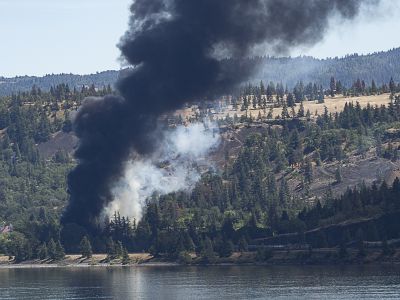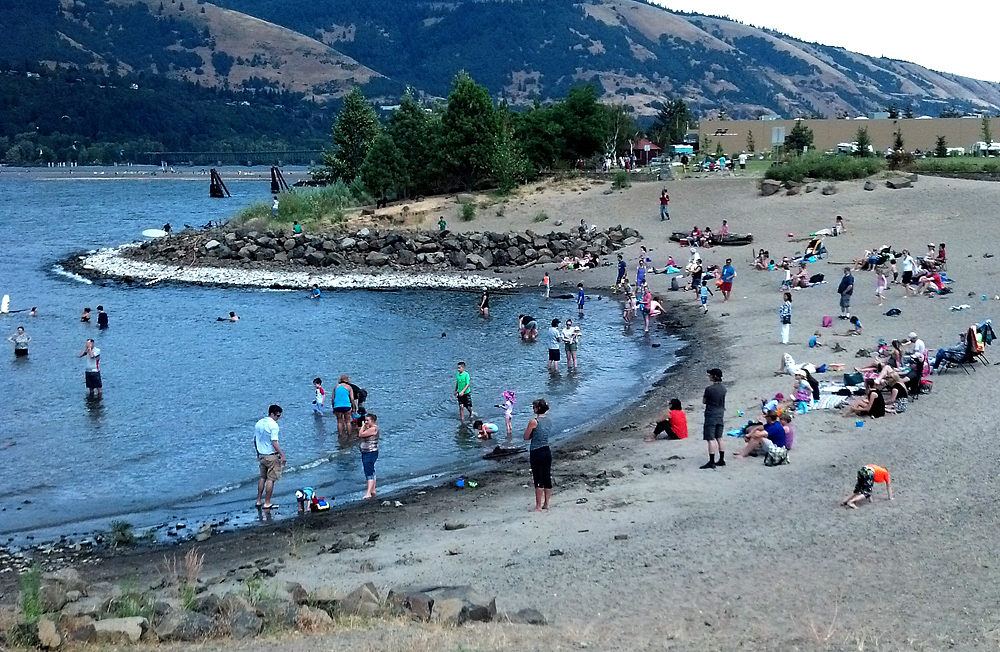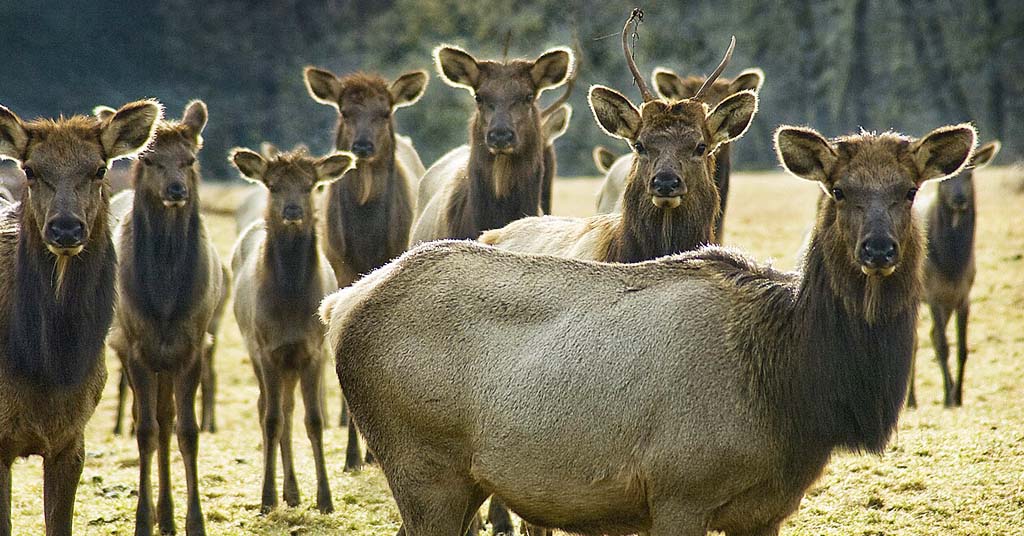On the eve of his surprise exit announcement, outgoing Columbia Riverkeeper executive director sees major threats ahead

Worth fighting for: The Columbia Gorge often presents an idealized image of a river dominated by industry. Photo: Jurgenhessphotography
By Chuck Thompson. May 5, 2022. “There’s such a need for a watchdog group on the Columbia. If there’s any place that deserves a strong presence and watershed-based approach it’s the Columbia River.”
So says Brett VandenHeuvel, executive director of Columbia Riverkeeper.
Check that.
The 48-year-old VandenHeuvel is the soon-to-be-former executive director of the Hood River, Ore.-based organization, which uses legal advocacy and community organizing in numerous conservation efforts.
On May 4, Columbia Riverkeeper announced the influential VandenHeuvel’s unexpected departure.
At the same time it named Legal and Program Director Lauren Goldberg the organization’s new executive director starting Aug. 1.

Ready for more: Columbia Riverkeeper Executive Director Brett VandenHuevel. Photo: Columbia Riverkeeper
VandenHeuvel, who will join Columbia Riverkeeper’s board of directors, assumed leadership of the organization in 2009. Over the last two decades the $3.5 million organization says it has grown tenfold. It’s certainly built a reputation as a tenacious fighter along the river in defeating over a dozen new fossil fuel terminal proposals, reducing toxic pollution and protecting salmon along the river.
“I’m going to stay closely involved, I care deeply about it,” says VandenHeuvel.
Via Zoom, Columbia Insight spoke with VandenHeuvel about his tenure as executive director and future plans.
Columbia Insight: Columbia Riverkeeper has been on an upward trajectory ever since you took over in 2009. Why leave now?
Brett VandenHeuvel: The organization has never been stronger. That’s part of the reason why it feels like a good time for some change. We have great leadership at Riverkeeper that’s going to take over. I’m personally ready for some change and new challenges.
CI: Such as?
BV: I’m starting a consulting practice to continue to do similar work, to focus on climate and clean water. And to do it nationally where I’ll work with nonprofits and tribal nations and foundations. There are a lot of lessons we’ve learned over the years. For example, the fossil fuel fights that we’ve been so successful on. Those are definitely heating up in other parts of the country, in the Gulf Coast, etc. I think we can share a lot of these hard-earned experiences.
CI: Where will you be based?
BV: I’m staying in Hood River. No major life changes.

Critical designation: Bradford Island was declared a Superfund site in March 2022. For decades, the U.S. Army Corps of Engineers used the island as a toxic waste dump. Screenshot: Columbia Riverkeeper
CI: What big issues will occupy incoming executive director Lauren Goldberg and the Riverkeeper staff in the near term?
BV: We’ve had tremendous success fighting fossil fuel projects. That is still a major focus. There are new pipeline expansions. There are new proposals for infrastructure in the estuary.
Bradford Island near the Bonneville Dam was really successful, working with the Yakama Nation to list that as a Superfund site. That’s a huge victory but we need to make sure the cleanup happens and is successful.
Another major focus, and an extremely challenging one, is how hot the Columbia River is becoming due to the dams and increase by climate change. If we’re going to prevent salmon from going extinct we can’t allow the river to warm up any more. And part of that is the Snake River dams. Snake River dam removal will continue to be a major campaign for Riverkeeper, I suspect.

New leadership: Lauren Goldberg. Photo: Columbia Riverkeeper
CI: When Idaho Representative Mike Simpson came out in 2021 with his plan to breach the dams there was a lot of excitement. Then Washington Governor Jay Inslee came out against it along with pretty much every Republican in the region. How realistic is breaching the Snake River dams?
BV: I think we’re in a better spot in the process right now. Governor Inslee and (Washington) Senator (Patty) Murray said they were going to spend a year to evaluate dam removal on the Snake. They’re doing that right now. And they’re going to come out with a recommendation that we’re hopeful recommends dam removal. … From there, we will need to convince Congress to act, but I think we’re in a much stronger position if its being led by Washington electeds as opposed to others.
CI: Will Inslee change his mind?
BV: I don’t think it’s changing his mind. I think they came out and opposed the overall Simpson plan. …The science is so clear. There’s been more and more political support for dam removal. Tribal nations throughout the Pacific Northwest have strongly supported dam removal. So I think things are lining up for the governor to become a champion for dam removal.
CI: In your outgoing statement you say: “Columbia Riverkeeper has never been stronger—and the stakes have never been higher.” What does that mean exactly, “the stakes have never been higher?”
BV: We’re right on the edge of an environment where salmon aren’t going to be able to survive in a polluted, overly hot river. We need to take some action soon. Addressing the temperature crisis on the Columbia is a major part of that. It’s also a time where it seems like more and more people are caring about the Columbia. It’s getting a lot more attention at the national level.
I do feel like we’re at a tipping point where it can go a couple ways. We can really invest in restoring the Columbia and have salmon runs thrive (along with) the cultures that depend on them. Or we can continue the status quo, which looks pretty dire in the years ahead.
MORE: As salmon cook in rivers, pressure on Biden mounts
CI: When you took over as executive director, Riverkeeper was in the news for the previous staff’s doctoring of evidence in the Ryan’s Juice controversy. What did you do as a new ED with that issue on a lot of peoples’ mind?
BV: That’s not quite what happened with the Ryan’s Juice stuff, but I understand the question. I had been staff attorney for a few years and when I became director we were going in a good direction.
I learned early on that we wanted to stay aggressive. That was one of the tenets I tried to keep throughout. These are serious issues; we have real consequences. And to be effective, our niche was to be aggressive. To not be afraid to file lawsuits against big corporations. To stand up for communities that were being steamrolled. To take on state and federal agencies that weren’t doing their jobs. To go after illegal pollution from companies that weren’t following the law. So that was a path that I wanted to establish and I feel like we’ve been able to do that.

Small steps, big gains: Local organization has been integral in Riverkeeper fights against fossil fuel infrastructure. Photo: Columbia Riverkeeper
CI: Was helping get the planned Oregon LNG facility on the Oregon Coast kiboshed in 2016 a pinnacle of your tenure?
BV: Yeah, the LNG victories in the estuary were hugely important regionally and for me personally. I kind of cut my teeth as a young lawyer working on those and built amazing relationships with communities in the estuary. And that really got us on the path to fighting a dozen other fossil fuel terminals and becoming a real leader in that space.
We were pretty early adopters of saying we can’t trade coal for gas and we need to try to move to clean energy entirely and not transition to fracked gas as this bridge fuel. That paid off when we jumped in early on the Kalama methanol refinery (opposition).
CI: Is the Columbia still a possible location for new fossil fuel infrastructure development?
BV: Yes, we are. They all look a little bit different now. … The big fossil fuel projects have lost enough where they’ve learned to put a green spin on some of them. Or describe things as maintenance projects when they would really double the capacity of the pipeline.
For example, the project called GTN [Gas Transmission Northwest] Pipeline—instead of building a new pipeline they’re building new compressor stations, which can add more gas to the system by compressing it more. It’s a huge amount of gas, but it’s not getting the attention it deserves. So we’re taking this very detailed position that we don’t want any new fossil fuel infrastructure for our climate. So it’s still a major threat.
CI: How do you assess the job the organization has done with Hanford during your tenure?
BV: We’ve had success at Hanford. For example, preventing it from being the nation’s nuclear waste repository. There have been proposals over time to send all the nuclear waste to Hanford. Or to make it the nation’s repository for other toxic pollution, like mercury, that we’ve been able to work with partners to fight off.
We’ve had a very strong presence during the cleanup planning process and have made those (plans) stronger. Hanford is an extremely frustrating place to work because of its slow pace and massive, entrenched bureaucracies. I think our biggest impact lately has been we’ve shifted our focus to really strongly partner with the Yakama Nation on Hanford cleanup.
MORE: Environmental justice at Hanford: Reconnecting Indigenous people to their land
CI: Is part of the problem that the scope of the situation at Hanford is really intimidating to understand?
BV: (One) issue is that Hanford was a very hot public issue in the ‘80s and ‘90s and it’s become less so as fewer and fewer people even know what it is. And that’s a problem because despite the glacial pace of the cleanup we need continued funding and we need to get it cleaned up or else it’s going to get a lot worse. And if people don’t care Congress isn’t going to care about it and that’s a problem.
CI: What outreach efforts during your tenure have been most successful?
BV: The most successful outreach is tied to specific actions. … Finding something that people can do where they can have success and ideally the more local the better. It’s not satisfying to write an email to a congressperson in Washington, D.C., who’s going to send you a form letter back. But it is satisfying to show up at a city council meeting and convince your city council by showing up over and over and over and it might only take 20 people to take some action.

Flammable issue: In June 2016, a Union Pacific train carrying crude oil to a refinery in Tacoma, Wash., derailed in the town of Mosier, Ore., along the Columbia River. Photo: Jurgenhessphotography
CI: Where are we are with coal and oil trains? Despite your work and that of others, and 2016’s fiery wreck in Mosier, Oregon, the trains continue along the river. What gains have been made, if any?
BV: There are still trains that are going to refineries in Puget Sound. There are some going to California. Yeah, but for example if the coal terminal at Longview, Washington, had gone in there would have been eight full coal trains and eight empty coal trains a day.
So we prevented a massive expansion of new coal and oil trains through the region. But, yeah, it’s still a transportation corridor. And we’re working with allies to try to stop some of those other refineries that continue to take trains. But I think the big victory was preventing those expansions.
CI: Have you got a favorite spot on the Columbia River?
BV: Lots of them! I love the estuary where the river meets the ocean. It gets wild down there. Skamokawa, Washington, is one of my favorite spots. There’s a county campground down there [Vista Park] where you can see the big ships go by and see the tides change. You can feel the energy of the estuary. It was built as a steamboat town facing the river so the roads feel like an afterthought.
The Hood River waterfront with my kids in the summer swimming as the sun’s going down is one of my favorite places on earth.
The Hanford Reach is amazing, paddling along and seeing the nuclear reactors but also seeing this really clear, free-flowing river. It’s amazing to see a river that big flow when we’re so used to stagnant reservoirs.

Sweet spot: Hood River waterfront. Photo: Jurgenhessphotography
CI: Amid all of the rancor and unseen grunt work, I feel like one thing that often gets lost is that people like you do the work you do because you genuinely love this place.
BV: That’s one of the great things about the Columbia. It’s not just something in the background. If it’s just scenery then we don’t care if it’s polluted, we don’t care what happens to it.
But we’re using it, right? I’m swimming there with my kids. We’re fishing, we’re eating the fish. People are recreating in it all the time. So it matters, you know, keeping it clean. Keeping it healthy matters not only for fish and wildlife, but for our communities.
Chuck Thompson is editor of Columbia Insight










